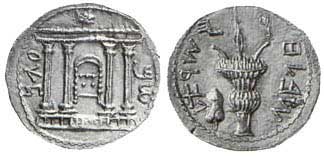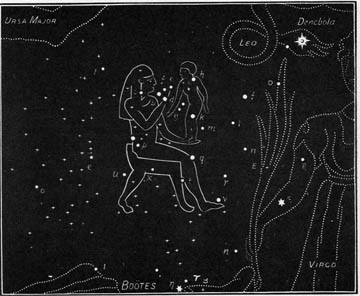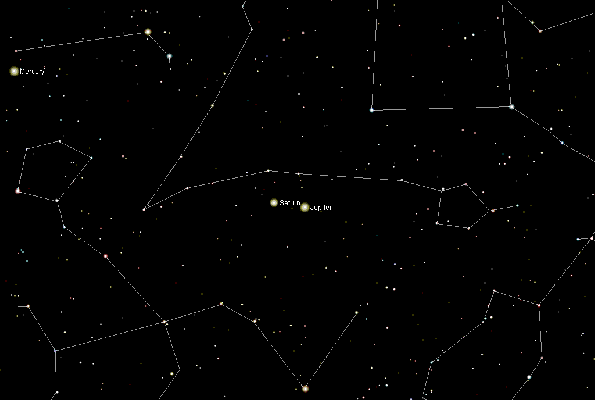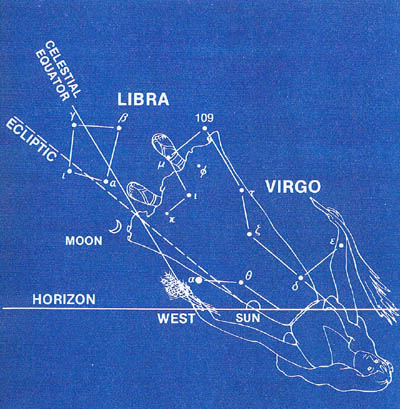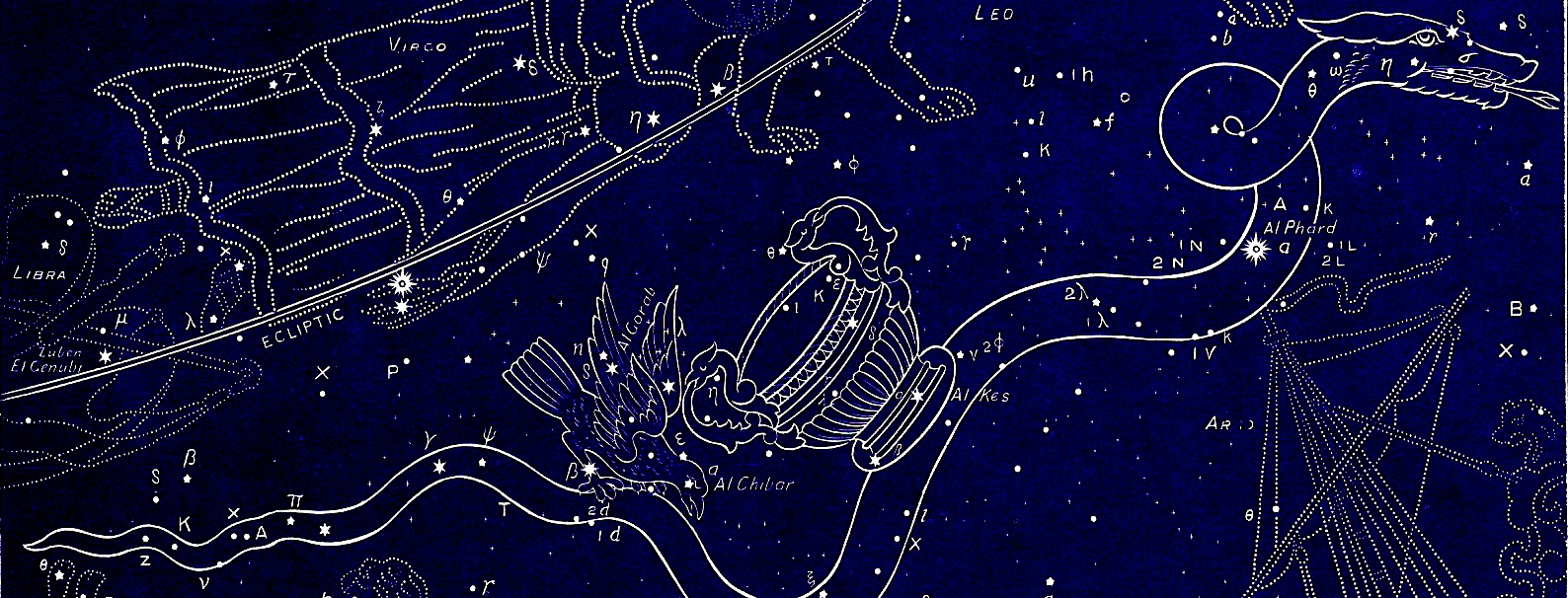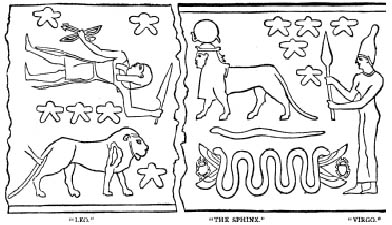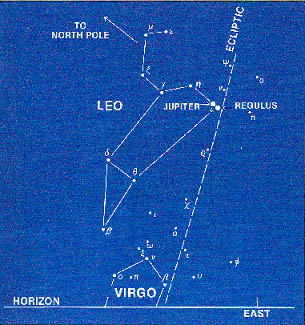
Biblical Cosmology and the Precession of the Equinoxes
Biblical Cosmology is focused on the Godly origin and structure of the Universe, viewing he laws of causality and Space-time in the context of the Creator as the First Cause. The traditional concept of the history of Cosmology reads as a timeline of the “discoveries” of the greatest scientists. Men like Ptolemy, Galileo, Copernicus, Kepler, Newton, Einstein and Hubble are the beacons of scientific progress, and certainly human science owes these men much. According to conventional history, the idea of a heliocentric “universe” or solar system, originated with the ancient Greeks, specifically Aristarchus of Samos back in the second century BC. This idea however, did not catch on in a big way until Copernicus, who while reviewing some of Aristarchus’ ideas, seized upon this concept and ran with it. He did this at his own peril due to the prevailing worldview of his time, especially that of the Roman Catholic Church, based on a geocentric view of the solar system espoused by Ptolemy, which held sway in intellectual and religious circles for over 1500 years. The graphic below from Harmonica Macrocosmica [A. Cellarius, Amsterdam 1660] depicts a Sun centered Copernican view of the cosmos.

This post on Biblical Cosmology will show that the idea of a heliocentric “universe” predates the 2nd Century BC and Aristarchus, by at least 1300 years, and its genuine roots are found in the Scriptures of the Old Testament. From a strictly historical perspective, this is somewhat of a radical statement, sure to have many critics, but once the following Biblical evidence is viewed in light of the principles of Biblical Astronomy, the foundations of this statement are inescapable. The subject of this blog states the case of potential revisionist power that Biblical Astronomy can have on the conventional view of the History of Astronomy. For Christian believers, knowledge of these truths provide a key historical view of the impact of the Biblical Patriarchs on the ancient world, which has been obscured by thousands of years of Astrology, pagan myth and yes, even human science. By restoring some of the original historical luster to these heroes of the Faith, [Heb. 11] we gain a fuller perspective of their mighty stand on the truth of God’s Word, as they upheld its general precepts including the Principles of Biblical Astronomy.
Our awareness of the history of Biblical Astronomy gains new insight as we consider the Biblical context of the Patriarchal astronomers, starting with Adam regarding their view of the heavens. God’s revelation and His Intelligent design of the cosmos, was taught to Adam personally and was handed down to the Biblical Patriarchs during Adam’s 930 year life span. In the Creator’s Revelatory Astronomy, the Patriarchs viewed the poles, ecliptic and Equator all relative to the orientation of earth’s axis, showing an aspect of precession as part of the Creator’s plan to depict a figurative geocentric position of earth’s central importance in the firmament. The earth, is not the literal center of the firmament, but because it is the object of the light shed by the other celestial bodies [Gen. 1:14-16], it is the figurative focal point of God’s Creation as man’s garden home. This is an aspect of the idea of the Sun’s dual year, since the solar year depicts a heliocentric, or sun-centered solar system, noting it’s daily illumination from earth’s view, as the central light of heaven. Thus the key implications of precession are seen, not only in the ages decreed by the Sun’s residence in one of the 12 signs of the zodiac, but also in the Biblical message that each zodiacal sign holds in relation to the returning Promised seed-Jesus Christ.
The Earth is thus the figurative center of Creation, as the object of the three-fold celestial light shed from the heavens. The purpose and beauty of this three-fold heavenly light is to illuminate the Earth, which God initiated with the two aspects of the Sun’s annual and precessional cycles, as seen in Joseph’s two dreams in Gen. 37:6-11. Joseph’s dreams reveal the basic correspondence of the 12 signs of the zodiac with the 12 tribes of Israel, among other things. Since the ancient view and knowledge of the Solar cycles, celestial signs, eclipses, and asterisms were based on line-of-sight relationships, that only have meaning from an Earth-bound view, over time this devolved into the view that the Earth was the literal center of all Creation, forming the basis of later geocentric theories, like those of Ptolemy. Similarly, as the figurative representation of the Sun as source of life, became literalized by the heathens, it resulted in the idolatrous Astrology of Sun worship inherent through much of ancient mythology and religion.
Plate I. Jupiter-Saturn Conjunction cycle
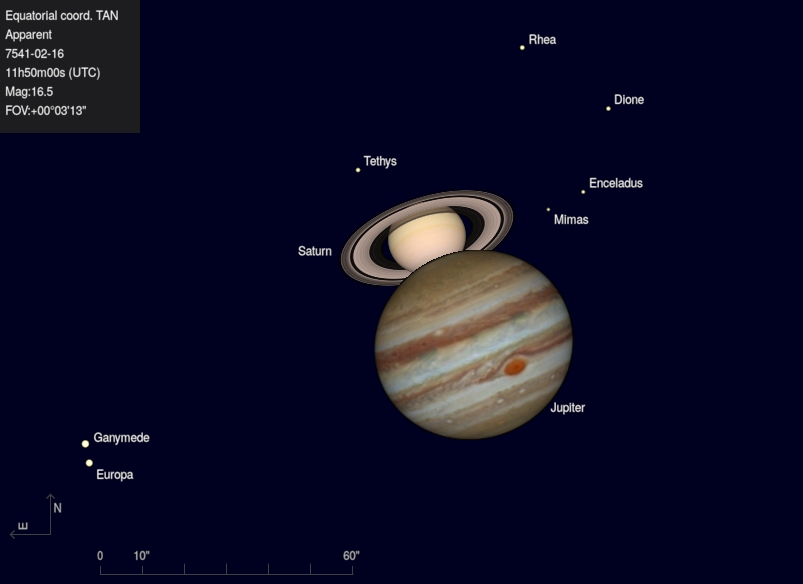
Another major influence on precession in the History of Astronomy was the Jupiter-Saturn Conjunction cycle. This was thought to open a window on the precession of the equinoxes, according to the base 60 mathematical pattern. The ancient Astronomy of numerous cultures including the Maya, Romans, Babylonians, Persians, Greeks, Chinese, and astronomers of ancient Egypt, calculated precession using this conjunction cycle in Pisces. The Chinese Zhuanxu Calendar is thought to have started in 1953 BC, linked with a significant predawn all-planet alignment on March 5th. According to astronomers Kevin Pang and John Bangert of the Jet Propulsion Labs, in an ancient text written by Liu Xiang [77-79 BC], this alignment took place near the Pegasus Square, [Plate II, below] between the two fish of Pisces. Pang stated: “While the beginning of a day is dawn, a five-planet conjunction occurring at dawn, with a new moon, and the start of spring would truly be the beginning of all cycles. For calendar makers, such a moment would also be an ideal starting point for counting days, months, years and planetary periods.” 1 The idea of a Jupiter-Saturn triple union taking place with a planetary alignment, indicates a possible termination point, where all solar system planetary cycles were in agreement early in their cycles. This idea agrees with Jupiter-Saturn triple unions occurring in Pisces only once every 800 years, showing how this Conjunction series subdivides the 25,920 year precessional cycle. Since 30 cycles of Jupiter-Saturn triple unions taking place in Pisces, totals a period of 24,000 years, it serves to generally break down this long cycle of precession, into 2000 year ages.
Figure 1. The Precession of the Equinoxes
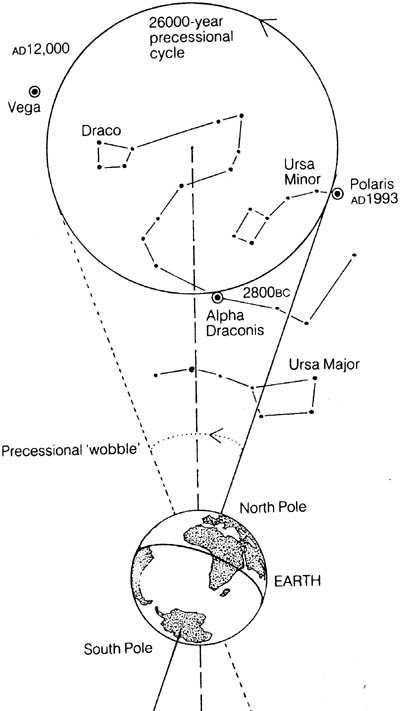
There was also a greater 260–year cycle based on Jupiter-Saturn Conjunctions, anciently utilized by the Mayans to break down the very long cycle of the precession of the equinoxes. Thompkins states that: the “Maya also had a cycle of 942,890 days, or 2,582 years, equlling 130 Jupiter-Saturn Conjunctions.”2
Twice this cycle [5,163 years], not only gave the equivalent of the greater 260-year cycle of Jupiter-Saturn conjunctions, but 100 of these greater 260-year cycles was equal to 26,000 years, often reckoned the length of the precession by the ancients, as seen in Figure 1 above. This agrees with evidence from Egyptian astronomy via their Dendera Zodiac.
The graphic of the Dendera Zodiac below shows the Pegasus Square, as a square scroll laid between the two Fishes, of Pisces with “Axis E” of this famed Egyptian Zodiac running through the corner of it. As we stated in our website study on the Stars of the Dendera Zodiac: the main Taurus-Scorpius Axis of this zodiac, with the Leo-Aquarius axis, match the main axes that identify the Age of Taurus in the Bible, in Numbers 24:7-9. The context of Numbers 2 shows us the order of 12 tribes of Israel in their wilderness encampment, matching the zodiacal order of the 12 signs/constellations on the ecliptic. In this way, the Dendera Zodiac not only provides key archaeological evidence that the ancient Hebrews and Egyptians both utilized a practical understanding of the precession of the equinoxes, but in the Hebrew’s case, they applied it directly to their belief in the prophecy of their coming redeemer, with Nature’s verification of their stellar gospel, in support of their Old Testament Holy Scriptures. Thus, the Zodiac of Dendera [See poster in the upper right margin of this blog Page] also provides strong supporting evidence from the history of Biblical Astronomy as to the belief in a coming redeemer, since this ancient Egyptian zodiac prophesies in very specific ways not only concerning the time he would appear, but also concerning his unique sacrifice via the very same celestial imagery utilized in the Bible. This important theme is set forth in John Lash’s realization of the presence of a 5th axis on this Zodiac, seen in Spica, the brightest star in Virgo. 3 The Hebrew name for Spica [Al Zemach]-the Branch/offspring of God, [Jer. 23:5-6] is embodied in God’s only begotten Son– Jesus Christ. Spica is only one of just two stars specifically marked on the Dendera Zodiac, the other being Sirius, the central star linked with the flood stages of the Nile, and the Sothic Calendar, registering one of the oldest historical calendar dates, 4241 BC. The 1461-year Sothic calendar also conforms to the 260-day pattern of the Tzolkin Calendar [260 x 1461] the same as 365.25 x 1040 days, adhering also to the pattern of Jupiter-Saturn conjunctions, as they break down the windows of the precession of the equinoxes through the ages.
Plate II. Axis “E” on the Dendera Zodiac
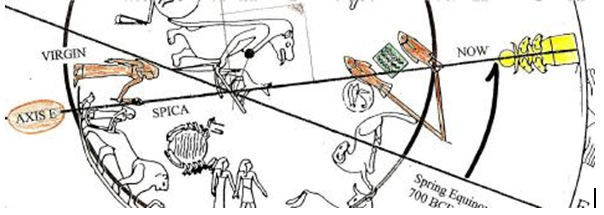
Lash’s comments concerning this 5th Dendera Axis are enlightening when viewed in context of the history of the Hebrew’s in ancient Egypt with Abraham, Isaac, Jacob and Moses, as a forerunner of Christ, and Lawgiver of Israel, who lead them through the wilderness unto the Promised Land. As Lash states in his unpublished
book, The Skies in Memory:
“Whoever designed the Dendera Zodiac was looking ahead in time to our [Piscean] age, when the spring equinox occurs under the tail of the western fish, because this is the time that the entire cycle culminates. With the spring equinox at this position in Pisces, the axial cross locks into unique alignment with the Galaxy.” Lash goes on to say that he considers the star “Spica… to be the master key to the Dendera Zodiac…” 4
The Dendera Zodiac marks our Piscean Age with the first appearance of the Branch and offspring of God, seen in how the axis referenced above, coincides with the star Spica and the opening of the Age of the Fishes.
The following chart shows how precessional ages correlate to the Biblical Administrations, revealing a consistent progression of themes as God’s Plan of the Ages unfolds. This provides the overarching context for God’s plan of redemption and restoration of Mankind and Creation, through the redeeming work of Christ-the centerpiece of the Ages.
Plate III.
| Zodiacal Sign | Biblical Administrations | Heavens & Earth | Precess Age Start Dates | Scripture |
| Sirius | Angels First Estate | First | Gen.1:1-2 | |
| Gemini | Original Paradise | Second | 6480-4320 BC | Gen. 3:8ff |
| Taurus | Bible Patriarchs | Second | 4320-2160 BC | Gen. 3:23ff |
| Aries | O.T. Law | Second | 2160-7 BC | Ex. 19:16ff |
| Pisces | Christ/Grace/Revelation /Millennium |
Second | 7BC-now | Matt. 3:11ff Acts 2:1ff IThess. 4:13 |
| Aquarius | Final Paradise | Third | 2153 AD | Rev. 21 |
This march of the precessional ages is recorded in certain ancient star maps like the Dendera zodiac, from ancient Egypt, in a recognition of the axes built into its structure. God designed triple Conjunctions of Jupiter-Saturn as individual markers and movements in a grand celestial Symphony of the Ages, ultimately leading to Christ’s Birth. The 1953 BC triple union of Jupiter-Saturn took place in the sign Aquarius, marking the Birth of Abram. As the Father of Many Nations, and progenitor of the believer’s line, Abraham via his offspring, Isaac and Jacob would bear the promised seed. This triple Conjunction confirmed that Christ came out of the nation of Israel, constituting the 12 tribes of Jacob, whose name God changed to Israel, to reflect their spiritual inheritance.
This is the spiritual message the heavenly Father intended to be communicated over the face of the Earth, a far cry from the “astrological ages” promoted in various cultural myths throughout history. Only with a Scriptural view of the precession of the equinoxes in its true Biblical context, can we gain the wisdom that God has stored for us in Creation’s master temporal cycle. Although at times we see the true light shining through the broken symmetry of mythology and sometimes even Astrology, we gain an unobstructed view when we take heed to the two part harmony of God’s written Word, with His celestial gospel. This approach truly provides the missing history that archaeo-astronomy has longed for.
Figure 2. Earth’s Axis and Precession
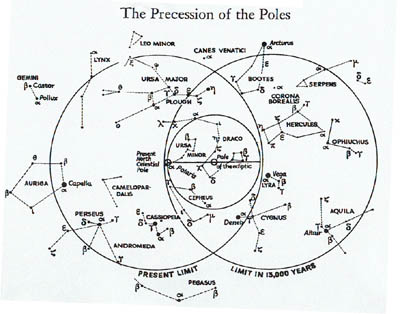
As part of the Creator’s grand design, the 25,920-year precessional cycle of the sun’s apparent retrograde motion against the backdrop of the tropical zodiac, depicts the Sun’s dwelling in successive zodiacal signs, dictated by the earth’s shifting axis and equatorial pole. Thus, with the precession of the vernal point, or vernal equinox in mind, the Earth is centrally located, depicting the earth’s figurative geocentrism referred to above, but not merely with respect to the solar system. The centrality of the Earth involves a much larger cosmic district than our community roundabout of the solar system. As Genesis 1:16-17 states, not only the Sun and Moon but also the Stars were to shed their light upon the Earth. This encompasses the entire zodiacal structure, the stars of the ecliptic, the Equator and the poles.
With the earth as the figurative center of Creation and the object of the three-fold celestial light shed from the heavens, the purpose and beauty of the cosmos is to shed its threefold light upon the earth, and God began with the dual year of the Sun, as we will see in Psalm 19 and in Joseph’s two dreams in Genesis 37. We find this dual year, in the Sun’s annual and precessional cycles.
Similarly, as the figurative representation of the Sun as the source of life became literally deified by the heathens, a result was the idolatry of Sun worship inherent in much of ancient world myth and Astrology. The Earth, of course, is not the literal center of creation, but God created it as man’s garden home and as the object of God’s Love and care for His human family, He showers humanity with His greatest Love as witnessed in this threefold celestial Light. Let’s take a more detailed look at what Scripture tells us about the precession of the equinoxes.
We can see how the geographic and magnetic poles on Earth are reflected in the North Poles of the ecliptic and the Equator, in the heavens as seen in Figure 3. below.
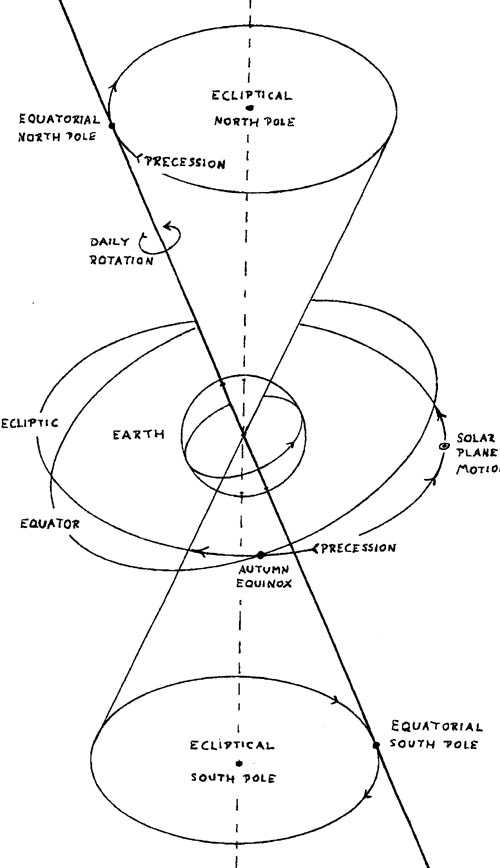
The Sun’s Cycle of Precession
Let’s begin with some initial Biblical evidence of precession in Psalm 19, as an introduction to the significance of the Sun’s “dual year,” or its annual and precessional cycles, the two prime standards for astronomical time. This differentiates the Sun’s dual year, first seen in it’s annual cycle, spending one month in each sign of the 12 Zodiacal signs, versus the retrograde precessional cycle, where it spends a “great month” or 2,160 solar years in the 12 signs of the ecliptic. As the Sun moves through all 12 signs of the tropical zodiac, the Sun completes its cycle of the “great year,” in about 25,920 solar years. The sixth verse of the 19th Psalm briefly refers to this apparent retrograde motion of the Sun:
Psalm 19:6
His going forth is from the end of the heaven, and his circuit unto the ends of it: and there is nothing hid from the heat thereof.
“His going forth is from the end of the heaven… a reference to the Sun’s path through the ecliptic, so called because all the solar and lunar eclipses occur on this course. The words “going forth” in Hebrew are mowtsa [*H4161], meaning the dawn, the east, a gate, the rising of the sun. 55
Thus it refers to the place or gate of the rising of the Sun, also known as the vernal point of the Spring Equinox, the sign of the zodiac where the sun rise occurs, indicating the sun’s retrograde precessional movement, because the sun rises in a different “gate,” or successive zodiacal house on average every 2,160 years. The sun’s annual cycle, or solar year is seen in “his circuit” above, which in the Hebrew is (*H8622) tequphah: rendered, “at the end of the year” [2 Chron. 24:23],6 an obvious reference to this annual solar cycle. Thus we have in brief, a Biblical contrast between these two solar cycles. The record of Joseph’s dreams in Genesis 37 will take us into greater depth on the Biblical testimony of precession. Joseph’s second dream in Gen. 37: 9-11 reveals a precessional context, with its use of stellar terms, especially the “eleven stars making obeisance” to his star or sign of the Bull, Taurus. These 12 “stars” of Joseph’s dream correlate with Jacob’s 12 sons in Gen. 49 forming the Sidereal zodiac. One can also view the precession of the Vernal equinox as the Sun in retrograde against the fixed background of the sidereal zodiac of the stars. Thus, Joseph’s second dream reveals astronomical truth that his first dream with an agricultural theme, does not.
Genesis 37:5-11
And Joseph dreamed a dream, and he told it his brethren: and they hated him yet the more. [6] And he said unto them, Hear, I pray you, this dream which I have dreamed: [7] For, behold, we were binding sheaves in the field, and, lo, my sheaf arose, and also stood upright; and, behold, your sheaves stood round about, and made obeisance [H7812] to my sheaf. [8] And his brethren said to him, Shalt thou indeed reign [H4427] over us? Or shalt thou indeed have dominion [H4910] over us? And they hated him yet the more for his dreams, and for his words. [9] And he dreamed yet another dream, and told it his brethren, and said, Behold, I have dreamed a dream more; and, behold, the sun and the moon and the eleven stars made obeisance [H7812] to me. [10] And he told it to his father and to his brethren: and his father rebuked him and said unto him, What is this dream that thou hast dreamed? Shall I and thy mother and thy brethren indeed come to bow down [H7812] ourselves to thee to the earth? [11] And his brethren envied him; but his father observed the saying.
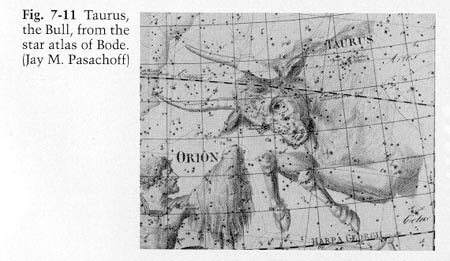
Taurus the Bull, as Joseph’s sign in the Hebrew zodiac was split into its two horns, representing his sons Ephraim and Mannasseh [Num. 2:18-20 & Deut. 33:17]. This was done to substitute for the rebellious tribe of Dan, made in the circle of the twelve Hebrew tribes, the twelve signs of the Sidereal zodiac. This allowed for the Levitical 13th tribe to be placed in the center of the zodiac’s circle, with the pattern of the stars mirrored in the seed of Israel, as they camped around their Tabernacle in the wilderness of Sinai during their forty years of wandering. This relation of the Levitical 13th tribe to the Sun, could be a symbolic reference to the Intercalation of a 13th month to align the solar and lunar cycles in the Hebrew Calendar. The Levites, being the priestly tribe, had the charge of the affairs for the Tabernacle, housing the Ark of the Covenant. An aspect of the Tabernacle’s celestial plan can be found in the edifice of the wooden framework that provided a foundation upon which the Tabernacle’s curtains [H3407]7 (Ps. 104:2-3, Isa. 40:22, Ex. 26:26-36), hung. They were assembled from 48 units, each ten cubits high, and 1.5 cubits wide…6 This implies the structure of these 12 zodiacal signs including their 36 decans, (12+36=48) divided into ten degree decans, showing not only God’s celestial order in the tabernacle of the Sun [Ps. 19:4], but also marking the earthly Tabernacle as the focal point reflecting the spiritual light of God’s presence among His people during the Old Testament. This was established in the priestly order of service instituted in the Temple by King David, with 24 courses of priests, each serving two times during Israel’s calendar year, totaling 48 weeks. When the three weeks of Passover, Pentecost and the Feast of Tabernacles are included, wherein all the priests served, we have the 51 weeks of Israel’s luni-solar year, divided according to sacred and civil standards. The sacred year began in Nisan, the month of the spring Passover, while the civil year in the fall started with the seventh month Tishri 1, the Day of Trumpets signaling the onset of Israel’s holiest month. This depicts the Creator’s light reflected in the celestial structure of creation, ruling over the Hebrew timekeeping, manifest in the sacred priestly service and architecture of the Old Testament Tabernacle and Temple, fulfilled in Jesus Christ as the King and High Priest, after the order of Melchizedek.
The Ark represented the fullness of the presence and power of God that could be manifested on Earth, amid the men of the Old Testament Law. As the “Sun” of the Hebrew Zodiac, the risen Morning Star will enliven humanity as their Savior and enlighten them as the light of the world. Here we see the Sun functioning as a “solar collector” as it moves through the various 12 houses in precession, reflecting the stellar light of their age upon the Earth. Once again we find Biblical evidence regarding the Hebrew zodiac, structured as the earliest known heliocentric model, as seen in the Menorah Solar System, far ahead of Aristarchus of Samos (270 BC), the first of the ancient Greeks to re-submit the idea of a Sun centered cosmos. With the light of the world at the center of the Hebrew zodiac, we see the roots for a Sun-centered solar system that Copernicus gets credit for, in spite of the neolithic antagonism of the Roman Catholic Church centuries after his death. This idea was first put forth and established with the Hebrew Menorah, which was structured on a celestial plan of the ancient solar system of seven celestial bodies, with the Sun as the central candlestick [Rev.1:20], embodied in Christ as the light of the world, always enlightening the Earth.
The Hebrew Menorah

A key to understanding this part of Genesis 37 is found as we take notice of details in the record, specifically the obeisance made by the sun, moon, and the eleven stars to Joseph’s sign of Taurus the Bull. The first dream makes no reference to Joseph’s parent’s who are represented as the Sun and Moon in the second dream. Their praise of Joseph’s star is added to that of the eleven stars of his brothers. The meaning of the Hebrew word (*H7812 shachah) to bow down, is to depress, prostrate oneself (in homage to royalty or God), to bow oneself down, to humbly beseech, worship or to do obeisance.8 This word is used as indicated in verses 7, 9 & 10 above, in reference not only to the sheaves of the field, but also to the sun, moon and eleven stars, with Joseph being the twelfth. Here we can see an image of the Hebrew zodiac foreshadowing the prophecy of Jacob over his twelve sons in Genesis 49, as an image of the Sidereal zodiac, seen as both the sheaves (earthly seed; Gen. 13:15-17) and stars (heavenly seed; Genesis 15:4-6), both relating to prophecies concerning Israel. Here we can see a record where the witness of the Stars lines up with the witness of the Scriptures according to the revelation of God to Joseph, to preserve the line of the promised seed of Israel, that the enemy was trying to wipe out with the famine that took Jacob to Egypt. We also find these two seeds mirrored in the horizontal and vertical fish of Pisces.
Joseph’s first dream had a terrestrial interpretation which was seen in [Gen. 45: 8 & 26], where the same Hebrew word used in verse 8, for “dominion” (maschal), is used with an immediate application to Joseph’s political position as “ruler throughout all the land of Egypt.” This was fulfilled when Jacob brought his family to Egypt according to God’s direction [Gen. 46:3-4], where Joseph was Grand Vizier.
The second dream however, being celestial in nature, shows a clear distinction from the first dream, indicating that there is another aspect of these signs of the ecliptic that we, as students of Biblical Astronomy, need to be aware of. The usage of (*H7812) here in Genesis 37, in relation to Joseph’s sign of Taurus, is distinctly different than in Genesis 49:8, where it states regarding Judah that: “thy Father’s children shall bow down (*H7812) before thee.” Obviously, even though the same Hebrew word is used for the homage that Jacob’s children would give to both Judah and Joseph, it cannot mean for the same reason.
The homage due Judah in Genesis 49 has a distinct celestial significance since the Messiah came from this tribe [Rev. 5:5]. You can view my Biblical Astronomy DVD for added insight in a detailed look at Gen. 49:8 in the triple Conjunction of Jupiter-Regulus marking the birth of Christ. For our purposes here Judah’s dominion refers to the Sun’s annual cycle through the zodiac seen in the Great Sphinx, where the woman’s head in Virgo, and the body of Leo the Lion are married, joining the two ends of the zodiac in this famous guardian of Giza. This also depicts one way that the Great Sphinx prophesies of the birth of Christ.
[What does this say for precession?]
The regal lion represents the homage due to Leo, the Lion of the tribe of Judah, the king of the Hebrew zodiac, seated on David’s throne; [Luke 1:32], born from Virgo the Woman and queen-Israel the earthly seed. Conversely, Joseph’s dominion refers to the Sun’s cycle of precession, and its dominion over the Sun, Moon, and the eleven Stars. The rule of the precessional cycle as the master cycle of the heavens is seen here in its Biblical context, as the Sun, Moon and Stars are interpreted in light of where the Sun rises at the vernal equinox in each precessional age, setting the over-arching context for each of the 2160 year ages. The precession of the equinoxes occurs due to the Sun’s annual path on the ecliptic in all 12 signs of the zodiac taking a solar year to complete, but at the end of that year the Sun does not return to the same point in the sign where it began the year, but is a little behind it… about 1 degree every 72 years. This takes about 25,920 years for the sun to complete this vast retrograde circle through all 12 signs on the ecliptic.
Genesis 37:10b-11 “Shall I and thy mother and thy brethren indeed come to bow down ourselves to thee to the earth? And his brethren envied him; but his father observed the saying.
Jacob’s response to Joseph’s dream is enlightening because Jacob himself and [Rebecca] are represented by him, to be the Sun and Moon, who together “made obeisance” to Joseph’s sign–Taurus, in his dream. This shows the Sun’s solar year and Moon’s lunar year, along with the star’s sidereal year, all in subjection to the base 60 standard of the Sun’s abode in precessional cycles. Jacob’s reference to the Sun and Moon in the dream as, “I and thy mother” shows the marriage of the solar & lunar calendars, harmonized according to the phi ratio, synchronized to the fifty-year Jubilee cycle of Israel. This accents the custom of Intercalation by the Biblical Patriarchs, Jacob and Joseph prior to Moses. When we consider the influence of Joseph as the Grand Vizier of Egypt in this record in Genesis 37, we find some of the earliest recorded incidents of Intercalation of the luni-solar calendar harmonized according to the phi ratio. Thus on one level, this record of Joseph’s dream underscores the kinship between the cycles of the Sun, Moon & Stars in view of both precession, and in light of the annual feasts Hebrew calendar. This sets the stage for later Biblical evidence of the Intercalation of months according to the Mosaic standards set in Num. 9:11ff. The record of the second Passover carried out by King Hezekiah in II Chron. 30:1ff, is an example of the insertion of a second Adar (13th) month. This was done usually when the two years had gotten too far out of synch.8
This insight into the record of Joseph’s dreams in Genesis 37 provides a basis for the Astronomy of the Biblical Patriarchs, especially their knowledge of the twelve signs of the zodiac, the harmonizing of the solar and lunar years, all in the ruling context of precession. We must be mindful that the Biblical Patriarchs were the experts of Biblical Astronomy because their gospel was the Stars. They had not received the written Scriptures as of yet, but they knew the “Covenant of Day and Night,” as Jeremiah [33:25] called it, better than anyone and were privy to its hidden mysteries, whose surface we are only scratching! Their astronomical expertise was carried into ancient Sumeria in Ur of the Chaldees, as seen in the “Tower of Babel,” [Gen. 11] record as the basis of ancient Babylonian Astronomy and was later perverted in their Astrology. This astronomical expertise of the Biblical Patriarchs like Abraham is one reason why Jacob “observed the saying,” of Joseph’s dream as Genesis 37:11 says.
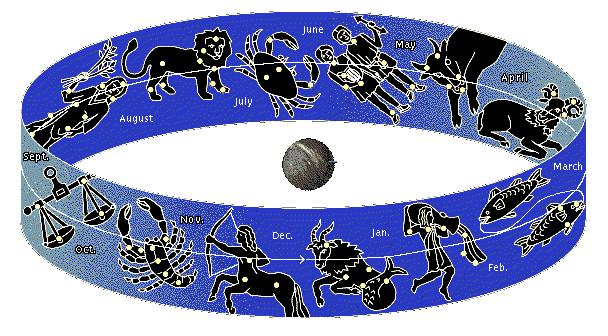
The Hebrew word for “observed” [*H8104–shamar], means: “to keep, guard, preserve, protect, retain, to observe as a covenant the commandments of God [Gen. 17:9-10, 18:19], and to revere.”9 It refers to the careful attention paid to the obligations of a covenant, as Abraham gave orders to “Keep the Way of the Lord.” The details of this Covenant of day and night, written in the stars are exactly what Jacob was protecting. When he noted the details of his beloved son’s celestial dream, he took great care to scrutinize the Word of the Lord as it came in this dream. After all, he was only following his Grandfather’s instructions, to keep the way of the Lord, for their Patriarchal Administration. In the oracle of Balaam in [Num. 24] below he is beholding the glory of Israel’s wilderness encampment, and he identifies three of the four tribes at the cardinal points of the compass; Aquarius in verse 7, with the water buckets, Taurus the wild Ox in verse 8, and Leo the Lion in verse 9.
Num. 24:2-9 [ESV]
2 And Balaam lifted up his eyes and saw Israel camping tribe by tribe. And the Spirit of God came upon him, 3 and he took up his discourse and said, “The oracle of Balaam the son of Beor, the oracle of the man whose eye is opened,[a] 4 the oracle of him who hears the words of God, who sees the vision of the Almighty, falling down with his eyes uncovered: 5 How lovely are your tents, O Jacob, your encampments, O Israel! 6 Like palm groves[b] that stretch afar, like gardens beside a river, like aloes that the Lord has planted, like cedar trees beside the waters. 7 Water shall flow from his buckets, and his seed shall be in many waters; his king shall be higher than Agag, and his kingdom shall be exalted. 8 God brings him out of Egypt and is for him like the horns of the wild ox; he shall eat up the nations, his adversaries, and shall break their bones in pieces and pierce them through with his arrows. 9 He crouched, he lay down like a lion and like a lioness; who will rouse him up? Blessed are those who bless you, and cursed are those who curse you.”
The cycles of the Sun and Moon bowing down to Taurus tells us that the precessional Age of Taurus is indicated, which is consistent with the witness of Numbers 23-24, that detail the precessional markers or cardinal points for this age. This precessional knowledge filtered through ancient Egypt and was applied along with the Sothic Calendar, during the Age of Taurus, as many archaeo-astronomers have documented. Even as Abraham is historically recorded among the first teachers of the ancient Egyptians, there were others before him. As Jacob’s grandfather, Jacob also would have been schooled in this Academy of Patriarchal Astronomy. This exerted a powerful influence on the Astronomy of the ancient Near East. We find this knowledge applied in the stellar alignment of many ancient Egyptian temples oriented to zodiacal signs signifying the related precessional age, providing strong evidence that the Biblical Patriarchs not only knew of the precessional cycle, but also applied it in a spiritual context, like their wilderness encampment around their Tabernacle.
As the discovery of the Antikythera Device has rewritten the modern understanding of astronomy in ancient Greece and Rome, so the mysteries of God’s Word will continue to transform human knowledge as more light is shed on these long hidden truths…
Footnotes
1. Pang and Bangert-Jet Propulsion Labs
2. Secrets of the Great Pyramid, Peter Thompkins
3. Atlantis Blueprint, Colin Wilson and Rand Flem-Ath, ppg. 171-172.
4. Skies in Memory, John Lash
5. Strong’s Concordance [H4161], James Strong
6. Ibid, [[H8622]
7. Ibid, [H3407]
8. Ibid, [H7812]
9. Ibid, [H8104]
Comments on Facebook

